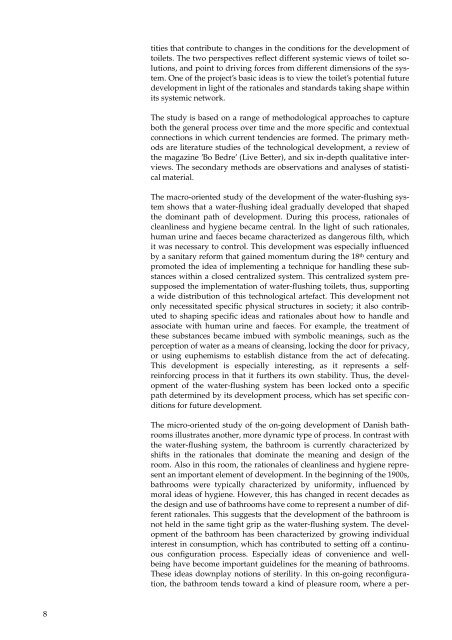Badeværelseskultur - en barriere for bæredygtig udvikling?
Badeværelseskultur - en barriere for bæredygtig udvikling?
Badeværelseskultur - en barriere for bæredygtig udvikling?
You also want an ePaper? Increase the reach of your titles
YUMPU automatically turns print PDFs into web optimized ePapers that Google loves.
8<br />
tities that contribute to changes in the conditions <strong>for</strong> the developm<strong>en</strong>t of<br />
toilets. The two perspectives reflect differ<strong>en</strong>t systemic views of toilet solutions,<br />
and point to driving <strong>for</strong>ces from differ<strong>en</strong>t dim<strong>en</strong>sions of the system.<br />
One of the project’s basic ideas is to view the toilet’s pot<strong>en</strong>tial future<br />
developm<strong>en</strong>t in light of the rationales and standards taking shape within<br />
its systemic network.<br />
The study is based on a range of methodological approaches to capture<br />
both the g<strong>en</strong>eral process over time and the more specific and contextual<br />
connections in which curr<strong>en</strong>t t<strong>en</strong>d<strong>en</strong>cies are <strong>for</strong>med. The primary methods<br />
are literature studies of the technological developm<strong>en</strong>t, a review of<br />
the magazine ’Bo Bedre’ (Live Better), and six in-depth qualitative interviews.<br />
The secondary methods are observations and analyses of statistical<br />
material.<br />
The macro-ori<strong>en</strong>ted study of the developm<strong>en</strong>t of the water-flushing system<br />
shows that a water-flushing ideal gradually developed that shaped<br />
the dominant path of developm<strong>en</strong>t. During this process, rationales of<br />
cleanliness and hygi<strong>en</strong>e became c<strong>en</strong>tral. In the light of such rationales,<br />
human urine and faeces became characterized as dangerous filth, which<br />
it was necessary to control. This developm<strong>en</strong>t was especially influ<strong>en</strong>ced<br />
by a sanitary re<strong>for</strong>m that gained mom<strong>en</strong>tum during the 18 th c<strong>en</strong>tury and<br />
promoted the idea of implem<strong>en</strong>ting a technique <strong>for</strong> handling these substances<br />
within a closed c<strong>en</strong>tralized system. This c<strong>en</strong>tralized system presupposed<br />
the implem<strong>en</strong>tation of water-flushing toilets, thus, supporting<br />
a wide distribution of this technological artefact. This developm<strong>en</strong>t not<br />
only necessitated specific physical structures in society; it also contributed<br />
to shaping specific ideas and rationales about how to handle and<br />
associate with human urine and faeces. For example, the treatm<strong>en</strong>t of<br />
these substances became imbued with symbolic meanings, such as the<br />
perception of water as a means of cleansing, locking the door <strong>for</strong> privacy,<br />
or using euphemisms to establish distance from the act of defecating.<br />
This developm<strong>en</strong>t is especially interesting, as it repres<strong>en</strong>ts a selfrein<strong>for</strong>cing<br />
process in that it furthers its own stability. Thus, the developm<strong>en</strong>t<br />
of the water-flushing system has be<strong>en</strong> locked onto a specific<br />
path determined by its developm<strong>en</strong>t process, which has set specific conditions<br />
<strong>for</strong> future developm<strong>en</strong>t.<br />
The micro-ori<strong>en</strong>ted study of the on-going developm<strong>en</strong>t of Danish bathrooms<br />
illustrates another, more dynamic type of process. In contrast with<br />
the water-flushing system, the bathroom is curr<strong>en</strong>tly characterized by<br />
shifts in the rationales that dominate the meaning and design of the<br />
room. Also in this room, the rationales of cleanliness and hygi<strong>en</strong>e repres<strong>en</strong>t<br />
an important elem<strong>en</strong>t of developm<strong>en</strong>t. In the beginning of the 1900s,<br />
bathrooms were typically characterized by uni<strong>for</strong>mity, influ<strong>en</strong>ced by<br />
moral ideas of hygi<strong>en</strong>e. However, this has changed in rec<strong>en</strong>t decades as<br />
the design and use of bathrooms have come to repres<strong>en</strong>t a number of differ<strong>en</strong>t<br />
rationales. This suggests that the developm<strong>en</strong>t of the bathroom is<br />
not held in the same tight grip as the water-flushing system. The developm<strong>en</strong>t<br />
of the bathroom has be<strong>en</strong> characterized by growing individual<br />
interest in consumption, which has contributed to setting off a continuous<br />
configuration process. Especially ideas of conv<strong>en</strong>i<strong>en</strong>ce and wellbeing<br />
have become important guidelines <strong>for</strong> the meaning of bathrooms.<br />
These ideas downplay notions of sterility. In this on-going reconfiguration,<br />
the bathroom t<strong>en</strong>ds toward a kind of pleasure room, where a per-

















